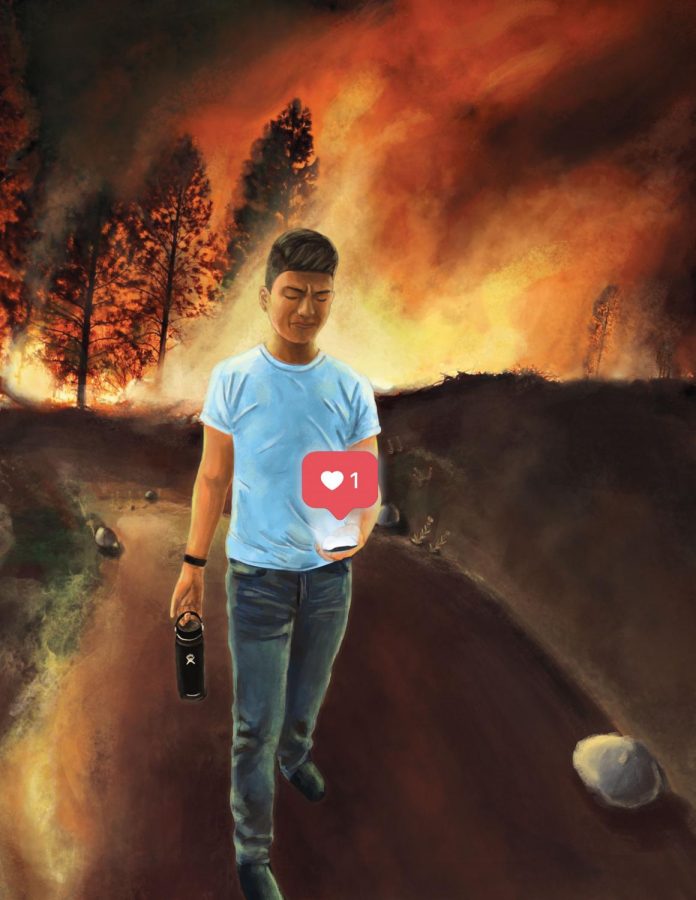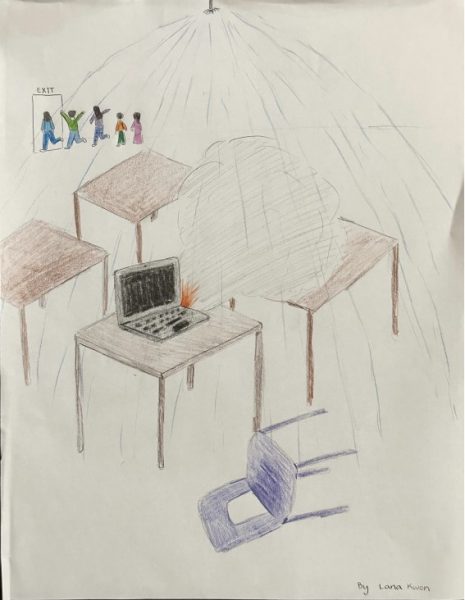To Repost or Reconsider
With society’s newest trend of reposting natural disasters, we should be aiming towards contributing to the disaster itself rather than posting the issue for attention
This person turns to Instagram in the midst of a fire.
In our modern era, society has taken a rather bizarre approach towards natural disasters: spreading the word with social media. Today, social media is inseparable from trends, where trends are created, and then are spread across the various social media platforms.
One such example is the August 2019 Amazon fires. After several twitter users tweeted an image of the Amazon Rainforest, the world’s largest concentration of biodiversity in an area, burning due to human-caused climate change, it took social media mere seconds to repost the tweet to their followers. The same could be said about the more recent Australian wildfires. An admiral action, one would say, is spreading awareness of an issue is critical in order to have an issue solved. Often times, however, reposters will casually go on about their day without aiding the extinguishing of the fires. Instead, they’ll find a photo of the actual fires (sometimes reposting old, unrelated fires), garner likes and followers and then do nothing for the rest of the day. Celebrities all over attempt to sympathize with the forest, despite displaying no interest in previous natural crises. Many others repost images of non-related fires in an attempt to catch in on the trend by gathering likes and retweets. This supposed way of “aiding” the issue is really only a path to getting the highly sought-likes. Such an example could be seen at the prestigious Golden Globes awards, where the celebrities kept praising and showing concerns to those individuals in threat under the Australian Wildfires, but then did nothing to stop it, despite being a room filled with multimillionaires. It’s a bandwagon trend now, not a call for action like it should be.
This proves something about society. Most of society is only in the trend to do environmentally-friendly tasks for pride and attention. The recent fires are not the only example as well, like many other trends such as the craze for Hydro Flasks. These high-quality metallic bottles that are both stylish and eco-friendly, have been the new craze of teenagers. Plastic straws are beginning to be viewed as destructive, after images of straws inside and outside marine life (i.e. sea turtles ingesting plastic bags and can holders choking sea lions, as seen in multitudes of news media such as National Geographic and BBC) were passed around social media. Soon, came the popularity of metal and avocado-pit straws, (the former being reusable, and the latter being biodegradable).
This is where I put my foot down. I respect that society is attempting to be more eco-friendly, however, it is often them prioritizing the attention given over actually helping those animals in need. Society could be doing much more than simply buying eco-friendly products. Instead, they could be funding groups whose sole purpose is to help a certain cause (i.e. World Wild Fund rehabilitation for endangered species of animals). Yes, posting does spread awareness, but it doesn’t often leave a mark if the reposter themselves are not helping the cause. It is often the pursuit of looking good and following society’s trends. Social media users can be better than this – don’t act like an ant colony mimicking each other as a hive mind, but as a human being looking for a change in this world.
Your donation will support the student journalists of Woodbridge High School. Your contribution will allow us to purchase equipment and cover our annual website hosting costs.

Hey there fellow Warriors! I'm a staff writer for the Woodbridge High School Golden Arrow. I learned all my journalism skills here at this school and my...

Hello Warriors! My name is Daniel Roman and I am an illustrator who loves the idea of sharing my creative passion with everyone through the Golden Arrow....









